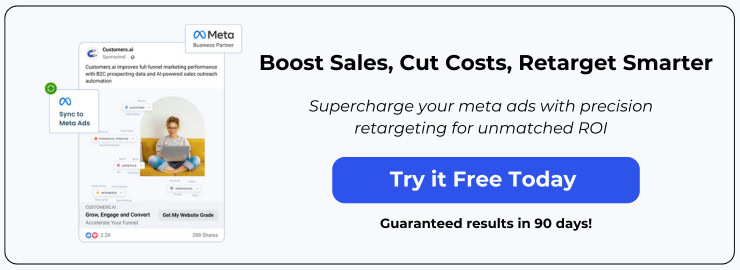Retargeting can sometimes feel a bit intrusive, with products you’ve browsed following you around the internet.
But what if retargeting could be smarter, more relevant, and less invasive?
That’s where list-based retargeting comes in.
By leveraging your own first-party customer data, you can retarget visitors with hyper-personalized ads and messaging that boost conversions. In this post, we’ll explore how to implement an effective list-based retargeting strategy.
What is List-Based Retargeting?
List-based retargeting flips the traditional model on its head. Instead of relying on third-party data from ad networks, you use your own customer lists and insights to retarget people.
This first-party data is more accurate, compliant with privacy regulations, and allows you to retarget based on real customer behaviors and characteristics.
With list uploads, you can segment audiences into hyper-relevant groups like:
- Past buyers of a specific product
- High-value customers based on lifetime value
- Cart abandoners
- Inactive subscribers
- Local customers in certain geographic areas
By controlling the data, you can show the right message to the right customer at the right time in their journey – drastically improving ad relevance and conversion rates.
Gathering and Uploading Customer Data
The first step is compiling your customer data and uploading it to a retargeting platform or ad network. Common data sources include:
- Email marketing lists
- CRM databases
- Loyalty program member details
- Purchase histories
- Mobile app user data
Many platforms allow you to create dynamic lists that automatically sync based on certain behaviors or criteria. For example, an “Abandoned Cart” list updating hourly based on website activity.
Once uploaded, these first-party lists become your retargeting audiences that you can target with tailored ads and creative.
Designing High-Converting Retargeting Campaigns
With audiences built, it’s time to craft retargeting ads and messaging that resonates.

Effective strategies include:
- Abandoned Cart Reminders: Send friendly nudges to customers who didn’t complete their purchase, highlighting the product(s) left behind. Offer an incentive like free shipping to seal the deal.
- Customer Winback Campaigns: Re-engage inactive buyers with personalized offers or new product announcements tailored to their interests. Remind them why they originally loved your brand.
- Cross-Sell/Upsell Promotions: Retarget past purchasers with complementary items or upgrades based on their previous orders. Leverage data to recommend highly relevant products.
- Location-Based Offers: For brick-and-mortars, use geographic data to share localized promotions and drive nearby customers into stores.
The key is delivering the right ad to the right person at the optimal point in their customer journey through precise audience segmentation and personalization – capabilities unlocked by first-party data.
Optimizing for Performance
As with any marketing channel, continuous optimization is critical for strong retargeting performance. Monitor metrics like click-through rate (CTR), cost per acquisition (CPA), and return on ad spend (ROAS) at the campaign and audience level.
Leverage insights from your best and worst performers to guide optimizations like:
- Creative refreshes with new ad copy, images, and offers
- Bid and budget adjustments by audience segment
- Expanding high-value audiences with look-alike modeling
- Sunsetting underperforming campaigns and audiences
By continuously analyzing results and iterating, you can maximize the impact of your list-based retargeting efforts.
Key Takeaways:
List-based retargeting empowers you to retarget customers with unmatched relevance using your own first-party data – driving conversions without being disruptive. To unlock its potential:
- Gather customer data from sources like email lists, CRMs, purchases, etc.
- Upload lists to build custom retargeting audiences in your ad platform
- Design tailored campaigns with personalized messaging for each segment
- Continuously optimize based on granular performance data
With a data-driven, customer-centric list-based retargeting strategy, you can delight customers and convert browsers into buyers more effectively than ever before.
FAQS
- How is list-based retargeting different from traditional retargeting?
Traditional retargeting uses third-party data to show ads based on website visits. List-based retargeting uses your real customer data for hyper-relevant ad targeting. - What are the benefits of list-based retargeting?
Key benefits include improved ad relevance, higher conversion rates, compliance with privacy regulations, and the ability to create super-targeted audience segments. - How do I build retargeting lists for my business?
Common sources are email marketing lists, CRM databases, loyalty program members, mobile app data, and past purchase data from your ecommerce platform. - What types of retargeting campaigns can I run with list-based retargeting?
Popular campaigns include abandoned cart reminders, winback campaigns for inactive customers, cross-sell/upsell promotions, and location-based offers. - How can I personalize retargeting ads with first-party data?
First-party data gives you insights into customer behaviors, interests, and past purchases to deliver highly personalized ad creative and messaging. - Is list-based retargeting more expensive than traditional retargeting?
Not necessarily – many ad platforms charge similar rates whether you use first or third-party data for audience targeting. - What ad platforms support list-based retargeting?
Major platforms like Google Ads, Facebook Ads, and most DSPs (demand-side platforms) allow you to upload customer lists for retargeting. - How do I get started with list-based retargeting?
First gather your customer data sources, upload to your ad platform, then create tailored retargeting campaigns for each audience segment. - How can I measure the performance of list-based retargeting campaigns?
Track key metrics like website traffic, conversion rates, cost per acquisition, and return on ad spend to optimize campaign performance over time.

